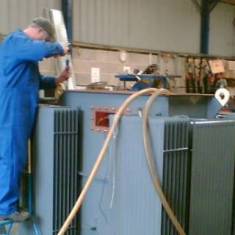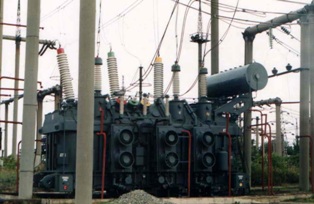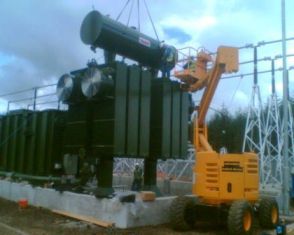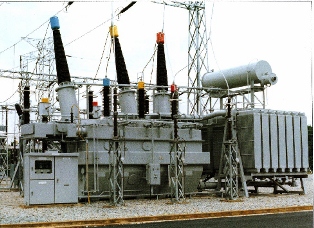Signs of failure of power transformers during operation
Transformer overheating
Transformer overload.
It is necessary to check the load on the transformer. For constant load transformers, the overload can be set using ammeters, for transformers with an uneven load curve - by taking a daily current schedule.
It should also be noted that transformers allow normal overloads, depending on the load curve, ambient temperature and summer underload. In addition, emergency overloads of transformers are allowed, regardless of the previous load and the temperature of the cooling medium.
Permissible temperature rises of the individual parts of the transformer and the oil above the temperature of the cooling medium, air or water must not exceed the standard values. If these measures do not give the desired effect, it is necessary to unload the transformer by connecting another transformer for parallel operation or disconnecting less critical consumers.
High room temperature for transformers. It is necessary to measure the air temperature in the transformer room at a distance of 1.5–2 m from the transformer tank in the middle of its height. If this temperature is more than 8-10 ° C higher than the outside air temperature, it is necessary to improve the ventilation of the transformer room.
Low oil level in the transformer. In this case, the exposed part of the coil and active steel overheats greatly; After making sure that there is no oil leakage from the tank, it is necessary to add oil to the normal level.
Internal faults of the transformer: short circuits between turns, phases; the formation of a short circuit due to damage to the insulation of the bolts (studs) tightening the active steel of the transformer; short circuits between the active steel sheets of the transformer.
All these disadvantages for minor short-circuits, despite the high local temperature, usually do not always give a noticeable increase in the overall temperature of the oil, and the development of these faults leads to a rapid increase in the temperature of the oil.

Unusual humming in the transformer
The pressure on the laminated magnetic circuit of the transformer is weakened. The clamping bolts must be tightened.
The splice break in the front magnetic circuit of the transformer is broken. Under the influence of the vibrations of the magnetic circuit, the tightening of the vertical bolts clamping the rods with weakened yokes, this changed the gaps in the joints, which caused an increased hum. It is necessary to suppress the magnetic core by replacing the seals in the upper and lower joints of the magnetic core sheets.
The outer sheets of the transformer's magnetic circuit vibrate. It is necessary to wedge the leaves with electrical cardboard.
Loose bolts securing the transformer cover and other parts. Check the tightness of all bolts.
The transformer is overloaded or the phase load is significantly unbalanced. It is necessary to eliminate the overload of the transformer or to reduce the load imbalance of the consumers.
Short circuits occur between phases and turns. The coil needs to be repaired.
The transformer operates on overvoltage. It is necessary to set the voltage switch (if present) to the position corresponding to the increased voltage.
Sending inside the transformer
Overlapping (but not breaking) between windings or taps to the case due to surges. The coil should be checked and repaired.
Interruption of grounding. As you know, the active steel and all other parts of the magnetic circuit in a transformer are grounded to drain to the ground static charges that appear on these parts, because the coil and the metal parts of the magnetic circuit are essentially the plates of a capacitor.
When the ground is interrupted, discharges can occur on the winding or its taps to the case, which is perceived as cracking inside the transformer.
Need for recovery grounding to the level at which it was carried out by the manufacturer: connect the ground at the same points and on the same side of the transformer, that is, on the side of the terminals of the low voltage winding. However, if the grounding is incorrectly restored, short-circuits can occur in the transformer, in which circulating currents can occur.

Breaking the windings of the transformer and breaking in them
Breakdown of the windings to the box between high and low voltage windings or between phases.
Causes of damage to transformer windings:
a) there are overvoltages associated with thunderstorms, emergency processes or switching processes;
b) the quality of the oil has deteriorated sharply (moisture, pollution, etc.);
c) the oil level has dropped;
d) the insulation has undergone natural wear (aging);
e) with external short circuits, as well as with short circuits inside the transformer, electrodynamic efforts.
It should be emphasized that overvoltages cannot cause insulation breakdowns, only overlaps between windings, phases or between the winding and the transformer housing. As a result of overlapping, usually only the surface of a few turns melts and soot appears on adjacent turns, but there is no complete connection between the turns, phases or between the winding and the transformer case.
Insulation breakdown of the transformer winding can be detected with a megohmmeter. However, in some cases, when bare spots appear in the form of points (point discharge) as a result of winding overvoltage, the defect can only be detected by testing the transformer with an applied or induced voltage. It is necessary to repair the winding and, if necessary, change the transformer oil.
Breaks in the windings of the transformer. As a result of a break or bad contact, part of the wire melts or burns. A fault is detected by the release of combustible gas in the gas relay and operation of the signal or trip relay.
Causes of breaks in transformer windings:
a) poorly soldered coil;
b) there was damage to the wires connecting the ends of the coils to the terminals;
c) during a short circuit, electrodynamic forces develop inside and outside the transformer. An open can be detected by reading ammeters or using a megohmmeter.
When delta connecting the transformer windings, the open circuit phase is detected by disconnecting the winding at one point and testing each phase of the transformer separately. Fracture most often occurs in places where the ring is bent under the bolt.
The coil needs to be repaired.
In order to prevent the repetition of interruption of the taps of the winding of the transformer, a tap made of round wire should be replaced by a flexible connection - a damper consisting of a set of thin copper strips with a cross-section equal to the cross-section of the wire.

Transformer gas protection
Gas protection against internal damage or abnormal operation of the transformer, depending on the intensity of gas formation, is triggered either by a signal or by a shutdown, or both simultaneously.
The gas protection is triggered by a signal.
Reasons for switching off the gas protection of the transformer:
a) there was some internal damage to the transformer, resulting in slight gassing;
b) when filling or cleaning oil, air entered the transformer;
c) the oil level decreases slowly due to a decrease in the ambient temperature or due to leakage of oil from the tank.
The gas protection of the transformer has tripped for signal and trip or trip only.This is due to internal damage to the transformer and other causes accompanied by strong gas formation:
a) there was a short circuit between the turns of the primary or secondary winding of the transformer. This damage can be caused by insufficient insulation of the transition joints, breakdown of the insulation of the turns during pressure testing or due to breakdowns on the coil copper, mechanical damage to the insulation, natural wear, overvoltages, electrodynamic forces during short circuits, coil exposure due to reduction in oil level.
A large current flows through the short-circuited turns and the phase current can only increase slightly; the insulation of the turns quickly burns, the turns themselves can burn, and the destruction of the neighboring turns is possible. In its development, the accident can turn into a phase-phase short circuit.
If the number of closed loops is significant, then in a short period of time the oil becomes very hot and may boil. In the absence of a gas relay, oil and smoke can be expelled through the safety plug of the expander.
A short circuit between the turns is accompanied not only by abnormal heating of the oil and a certain increase in current on the supply side, but also by a decrease in the resistance of the phase where the short circuit occurred;
b) a phase-phase short circuit has occurred, caused by the same reasons as the insulation breakdown and proceeding violently. In this case, the oil can be discharged from the expander or through the membrane of the safety tube, which is installed in transformers with a capacity of 1000 kVA and more;
c) a short circuit has occurred due to insulation failure of the bolts clamping the active steel of the transformer. The short circuit heats up a lot and causes the oil to overheat. The bolt and nearby active steel sheets can be destroyed. In transformers with frontal magnetic circuits, a short circuit may occur in contact with the yokes of the pads pressing the rods;
d) a short circuit occurred between the sheets of active steel due to a breakdown of the insulation between the sheets as a result of natural wear (aging) of the insulation. Significant eddy currents contribute to a large local overheating of the active steel, which over time can lead to local burning of the steel (fire in iron). In the front magnetic circuits, strong heating of the joints by eddy currents may occur due to damage to the seals in them;
e) the oil level in the transformer has dropped significantly or the air is intensively separated from the oil due to sudden cooling or after repair (filling with fresh oil, cleaning with a centrifuge, etc.).
It should be emphasized that in practice there have also been cases of false operation of the gas protection due to malfunction of the secondary switching circuits of the protection. For example, the operation of the gas protection of a transformer can be caused by various reasons. Therefore, before proceeding with troubleshooting, it is necessary to accurately establish the reason that caused the gas protection to work. To do this, it is necessary to find out which of the protections (relay) worked, conduct a study of the gases accumulated in the gas relay and determine their flammability, color, quantity and chemical composition.
Gas flammability indicates internal damage. If the gases are colorless and do not burn, then the reason for the action of the relay is the air released from the oil. The color of the emitted gas makes it possible to assess the nature of the damage; white-gray color indicates damage to paper or cardboard, yellow - wood, black - oil. But as the color of the gas may disappear after some time, its color should be determined as soon as it appears. A drop in the oil's flash point also indicates internal damage. If the reason for the operation of the gas protection is the release of air, then it must be released from the relay. When the level drops, the oil must be topped up, turn off the gas protection from the braking action.
If the coil is damaged, it is necessary to find the location of the damage and carry out appropriate repairs. For this it is necessary to open the transformer and remove the core. Shorted winding turns can be found when the transformer is switched from the low voltage side to the live side. The short circuit will be very hot and smoke will appear from the coil. In this way, other short circuits can be found.
Damaged spots in the active steel can be found when the transformer is running at idle (with the core removed). These places will be very hot. In this test, the voltage is applied to the low voltage coil and ramped up from zero; the high voltage winding must be pre-disconnected in several places to avoid damage to the winding (due to lack of oil).
The short circuit between the sheets of the active steel of the transformer and its melting must be eliminated by recharging the damaged part of the magnetic circuit with replacement of the inter-sheet insulation. Damaged insulation in the joints of the magnetic circuit is replaced with a new one, consisting of asbestos sheets with a thickness of 0.8–1 mm, impregnated with glyphtal varnish. Cable paper with a thickness of 0.07-0.1 mm is laid on top and bottom.

Abnormal transformer secondary voltage
The primary voltage of the transformer is the same and the secondary voltage is the same at no load, but varies greatly at load.
Reasons:
a) poor contact when connecting one terminal or inside the winding of one phase;
b) breaking the primary winding of a rod-type transformer connected according to the delta-star or delta-delta scheme.
The primary voltages of the transformer are the same and the secondary voltages are not the same at no load and at load.
Reasons:
a) the start and end of the winding of one phase of the secondary winding are confused when star-connected;
b) open in the primary winding of a star-star connected transformer. In this case the three line secondary voltages are not zero;
c) open in the secondary winding of the transformer when connected according to the star-star or delta-star scheme. In this case, only one line-to-line voltage is non-zero, and the other two line-to-line voltages are zero.
In a delta-delta connection scheme, an open circuit of its secondary circuit can be established by measuring resistances or by heating the windings: the winding of a phase that has an open circuit will be cold due to the lack of current in it. In the latter case, temporary operation of the transformer is possible with the current load of the secondary winding, which is 58% of the nominal. Repair of the windings is necessary to eliminate faults that cause symmetry violations of the secondary voltage of the transformer.
